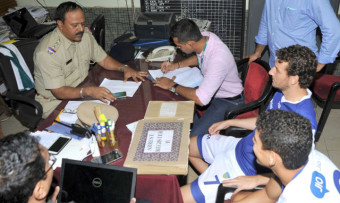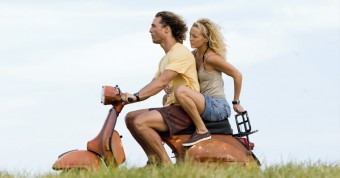Dionysian delights at Konkan Fruit Fest
There is a fruity aroma in the air, illness along with the earthier tones of vermicompost. What goes into the ground shares space with what hangs high in the air along with all the food products they generate, at the Konkan Fruit Fest at the BPS Grounds in Margao, organised by the Botanical Society of Goa. This is the first time the fest has been held in South Goa, it took place from 10th to 12th May.
There is a vast range on display, from papaya jam and red hibiscus syrup to jackfruit wine and vinegar, from lime squash and rice wine to fruits like pomelon, Mexican bananas and citron. They all look mouth wateringly tasty, but a young girl looks at us sternly, carrying a board that warns against eating any of the fruits.
The enthusiastic Pilar Fathers of the Zogati Nature Farm at Birondem, Sattari are there, and so are the folks from Krishi Vigyan Kendra, ICAR and other nurseries and farms. There’s even a bio-gas tank on display that promises two hours of gas in exchange for adding 5 kg of wet organic waste every day.
The fruit wine counters are doing brisk business. There’s Maria do Ceu Carvalho of Velsao, and Anslem Mascarenhas of Parra with their bottles of cashew, ginger, jambool and other wines.
Hansel Vaz of Dona Maria, a small family run bottler in South Goa is cheerfully showing off the classy glass bottles that hold his cashew and coconut feni. His brand ‘Cazulo’ feni was launched on 10th May, just a few days back. Cazulo means firefly in Konkani. The bottle is square based, tapering upwards, a replica of the old bottles used in the Portuguese period. The firefly motif decorates the glass surface in relief. It’s a nice minimalistic design.
“There should not be too much elaboration on the bottle,” says Hansel. “The feni should be the hero, not the bottle. The feni is stored in garafaos (traditional green glass jars) for a year. I got a local artisan to make the wickerwork for the garafao.”
The poster for Cazulo feni shows the entire process of making feni, right from the plucking of the cashew apple or collecting coconut sap to the final sip by the bon vivant drinker. The cheerful characters have been drawn by artist Sharmila Coutinho.
“People ask me why I have spent so much money and effort on all this design, but I feel feni has to be rebranded. We can’t keep dragging on the same ideas of 25 years back. I am a geologist; I have travelled and have seen how cultures position themselves. When we sell feni in plastic bottles with pictures of women and the beach, we cheapen ourselves and our culture.”
Hansel has used the red colour of the kunbi sari for the label and the matolli flower hangings for the label border. “The cazulo is a familiar insect in Goan nights and yet also a universal motif,” he tells me.
“I’m working with the local distillers to improve the quality of feni by going back to traditional methods. Some of them use oil drums for the distillation process instead of the traditional earthen pot,” says Hansel, showing me photographs of such drums being used.
Hansel proudly tells me that CNN Travel has rated his Cazulo Feni among the Top 9 Spirits of Asia. The Cazulo bottle also ranked in the final five for the New Zealand Best Awards.
John Carmo Rodrigues displays a Jambool wine
I stroll on to another stall and am intrigued by an elderly gentleman who stands behind an array of fruit wine bottles.
John Carmo Rodrigues belongs to an older generation, but is still bustling with suave old world charm. Goan Homemade Tonic Wines is 80 year old Rodrigues’ labour of love. His stall displays posters extolling the virtues of wines made from jambool, ginger, papaya, cashew, aloe vera, muskmelon and many more. Rodrigues knows what he is talking about; after all he holds a doctorate in medical microbiology. He worked with the German pharmaceutical giant Hoechst for 30 years, in its pharma, veterinary, agrochem and diagnostics divisions in India.
He speaks proudly of the work he did in Goa in 1971-72 when he oversaw the aerial spraying of cashew crop that had been infested by the T-Mosquito pest.
Rodrigues retired in 1986 and tool up rural service in Baida, Chinchinim. “We are served so much by the Gaudda people, so I decided to give something back,” he says with a simple smile. He conducted health camps, counselling sessions, took care of pregnant women and under nourished children and set up a carpentry center. The wiry and fit octogenarian has a yoga therapy center in Margao and is also a yoga consultant at the Leela hotel.
How did he get into wine making?
“In my college days back in 1955, we had a lot of jambool trees at home, and the fruit would fall and the pigs and cattle would make a mess stomping them. So I made my first batch of jambool wine. Those days we used to get imported brands, and folks were surprised that my wine tasted so good.”
“In every fruit there is normal flora,” Rodrigues educates me. “Even a human being has about one and a half kilo of bacteria in the gut. There are various types of bacteria – the pathogens cause disease, there are also helpful ones that make vitamins, etc.”
“When left to ferment, the natural flora plays the role of natural yeast. But it’s a risky process, because with the slightest contamination the fermented juice can turn to vinegar. That’s why winemakers accelerate the process of alcohol formation by introducing yeast. I use imported Australian fruit yeast.”
A woman come up to him and enquires into a jambool kernel and seed powder that Rodrigues recommends for diabetes. “Tell me the exact fasting blood sugar, and then I can tell you the dosage,” advises Rodrigues, with a gentle professional mien.
The former Governor of Goa SC Jamir had sent him a letter appreciating his medicinal wine. Rodrigues produced a batch of that same wine and has pasted labels containing Jamir’s letter on the bottle which is he calls Governor wine.
“Yesterday I heard a boy came here asking for a wine for his diabetic mother,” Rodrigues turns aside to tell the ladies manning his counter, both appear to be his relatives. “If such people come, give them the bottle for free. If they don’t have money, we must help them.”
There have been monks in Goa who have bottled many a gallon of wine, but this affable winemaker is truly a saint.
.
.
.






